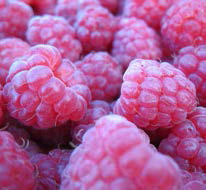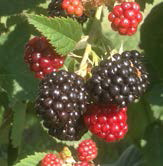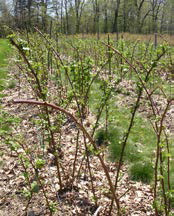Raspberries can be an enjoyable crop for the conscientious gardener. A well-maintained raspberry bed can provide fruit for 10 to 20 years. Red raspberries grow well throughout New England, but black and purple raspberries and blackberries lack the hardiness to be grown north of well-sheltered sites in southern Maine and New Hampshire. All together, these crops are known as “bramble crops”. In this fact sheet, we discuss all brambles, but focus on raspberry.
Selecting a Planting Site
To get the most out of your raspberry planting, you must choose your planting site carefully. Raspberries prefer full sunlight and grow best in well-drained, sandy loam soils rich in organic matter. Avoid low areas that remain wet late into the spring, but select a site with access to a water supply. Irrigation is important for good plant growth during dry periods and can improve fruit size and yield. Do not plant raspberries where tomatoes, potatoes, peppers or eggplant have been grown within the past four years, because these crops carry a root rot, called Verticillium, which can also attack raspberries. Destroy all wild bramble plants within a distance of 600 feet of the site if possible, to reduce the possibility that viruses might spread to your planting.
Preparing the Soil
Getting the soil ready for raspberries may take up to two years, depending on its condition. Test the soil to determine its pH and fertility levels. Soil testing can be done through a number of private and public labs. UNH Cooperative Extension offers this service. Forms and instructions are available on our website: extension.unh.edu/Problem-Diagnosis-and-Testing-Services/Soil-Testing, or you can call your local county Extension office or our Info Line at 1-877-EXT-GROW (1-877-398-4769).
Raspberries grow best in a soil pH of 5.6 to 6.2; this may require applications of ground limestone. Because it takes time for lime to raise the pH, lime should be added at least a year before planting if it is needed. To improve the level of organic matter in the soil, and to kill out perennial weeds, sow a cover crop, such as buck- wheat, rye, millet or oats, and plow it into the soil before it goes to seed. There should be time enough for two sowings in a single season.
Applications of organic amendments such as leaf compost or manure, followed by regular periodic tillage for a full season may be used as an alternative to cover crops.
Soil amendments should be determined based on a soil test. If you do not have soil test results, several days before planting, broadcast 25 pounds of 10-10-10 garden fertilizer per 1000 square feet of the site, cultivate the soil to incorporate the fertilizer and break up any clumps or clods. Organic fertilizer sources such as plant or seed meals, sulpomag and rock phosphate may be used in place of synthetic fertilizers. Apply enough of these materials to deliver 2.5 pounds each of nitrogen, phosphorus (P2O5) and potassium (K2O) per 1000 square feet.

Red raspberries grow well throughout New England, but black and purple raspberries and blackberries lack the hardiness to be grown north of well-sheltered sites in southern Maine and New Hampshire.
The Raspberry Plant
The crowns and roots of raspberry plants are perennial, but individual canes live two years. Each spring, plants produce canes from buds on the crown and underground lateral stems. These canes grow during the first year, overwinter, and produce fruit during the summer of the second year, while new canes emerge to provide a crop for the following year. Second-year canes die shortly after fruiting. Canes are called primocanes during their first year, and floricanes during their second year. Everbearing raspberries bear a crop on primocanes in the fall, and then produce a typical summer crop as well as a fall crop the second year.
Did You Know?
Canes are called primocanes during their first year, and floricanes during their second year.
Suggested Cultivars
Although several raspberry varieties are available, only a few will do well under the short growing seasons and severe winters of northern New England. Select only those that are rated very hardy. For fall-bearing raspberry, avoid those that ripen in very late fall.
In general, red raspberries are hardier than purple raspberries, black raspberries and blackberries. Temperatures below - 5o F will kill blackberry and most purple and black raspberry canes, so these should only be planted in southern parts of Maine and New Hampshire, on protected sites.
Order your plants from a reputable nursery or garden dealer. Specify disease- free, virus-indexed stock. Most raspberries are sold as dormant, one-year-old canes, but some nurseries offer plants generated by tissue culture, or micropropagation. Tissue cultured plants may be more expensive, but they are less likely to have disease problems.

that are just starting to ripen.
Red Raspberries
Prelude: Early ripening. Medium-sized fruit with fair flavor. Very hardy.
Boyne: Early ripening. Large crops of medium-sized, dark red berries with good flavor. Short, spiny canes. Very hardy.
Killarney: Ripens mid-season. Medium-sized, bright red fruit with good flavor. Short, spiny canes with many fine thorns. Very hardy.
Nova: Ripens mid-season. Firm, acidic fruit with good flavor. Plants are vigorous with few thorns. Very hardy.
Taylor: Ripens late-season. Medium-sized fruit with excellent flavor. Moderately hardy, but disease susceptible.
Everbearing Raspberries
Autumn Britten: Early-ripening for a fall raspberry. Produces large, dark red, high quality fruit with very good flavor.
Caroline: Medium-late fall raspberry (may not ripen in Northern areas). Medium-large fruit with good flavor. Very vigorous and spreading canes.
Anne: The earliest yellow fall raspberry. Ripens to a golden yellow. Medium-sized, very sweet fruit. Very vigorous and productive canes.

cultivar that can be managed for both
summer and fall crops. It produces
sweet golden-color fruit.o
Purple Raspberries
Royalty: Late ripening. Large, round reddish purple fruit, soft, with good flavor. High yielding. Large vigorous canes with thorns. Susceptible to root rot. Moderately hardy.
Success: Mid-to-late ripening. Small, dark purple fruit with good flavor. High yielding. Slow spreading plants, with thorns. Difficult to propagate. Hardy.
Black Raspberries
Jewel: Mid-season ripening. Firm, glossy fruit with good flavor. Vigorous, erect plants. Moderately hardy.
Blackberries
Darrow: Large, glossy fruit with good flavor. Vigorous, erect plants with large thorns. Moderate hardy.
Illini Hardy: Large, good quality fruit. Very thorny plants. Reported to be hardy to - 20oF.
Did You Know?
In general, red raspberries are hardier than purple raspberries, black raspberries & blackberries.

shown above, requires additional
winter protection in order to survive in
most NH sites.
Planting and Management Systems
Raspberry plants should be planted early in the spring after the danger of severe frost is past (in late April to early May). Do not allow plant roots to dry out prior to or during planting. Plants should be set at the same depth or slightly deeper than they were in the nursery. Firm the soil around the roots and water the plants. If one-year-old canes are used, cut them back to a height of four to six inches above the ground.
Red raspberry plants are typically grown in a hedge row. Crowns should be planted about two feet apart in rows that are eight to 12 feet apart.
Choose the wider spacing if you’ll be using large equipment, such as tractors, in the planting. The plants will soon send up suckers from the roots and crowns to form a hedge, which should be maintained at 12 to 18 inches wide.
Purple and black raspberries and blackberries only produce suckers from the base of the crown and will not fill out a hedgerow as red raspberries do. For this reason, they are frequently grown in the hill system to get the most production out of individual plants. For this system, plants should be set four feet apart in rows eight to 12 feet apart.
All raspberries should be grown with some sort of a trellis. For plants grown in a hedgerow, the “T” trellis system is recommended. Sturdy posts should be set in the row with 3 1/2 foot long cross arms affixed at a height of 3 1/2 feet. The posts should be set at least two feet deep in the ground and anchored at each end of the row. Secure heavy gauge wire along the length of the row on each side of the cross arms. Tie fruiting canes to the wires on each side to make harvest easier and reduce fruit loss. The “T” trellis also makes pruning easier by encouraging new cane growth to occur in the middle of the row, rather than the outside edges.
For black and purple raspberries and blackberries grown using the hill system, a sturdy post is set next to each plant (four feet apart in the row). A wire can be run along all the posts in the row, about 4 1/2 feet above the ground. The fruiting branches of each plant should be spread along the wire, or the canes of each plant can simply be tied to the post next to them.


Care and Fertilization
Keep the planting completely free from weeds with shallow cultivation and hand pulling as necessary. Make sure the plants receive one to two inches of water a week for best growth. Mulch can be used to reduce weed problems within the plant rows. Spread sawdust, bark, pine needles or rotted leaf mulch over the plant rows and maintain at a depth of three to four inches. In addition to weed control, mulch will help retain soil moisture and add valuable organic matter; however, the use of mulch will increase the risk of winter injury by delaying plant hardening in the fall.
Starting the second year of the planting, a cover crop can be planted between the rows. An annual cover crop, such as spring oats, can be sown just after harvest. The oats will aid in hardening off the raspberry plants for winter by using up excess water and nutrients in the soil and will also reduce weed growth. Oats will be killed by low winter temperatures, and the dead sod cover will reduce soil erosion and weed seed germination in the spring.
A permanent cover crop may also be sown following harvest the second year. A non-competitive grass cover, such as a bluegrass-fescue mix, can be sown between the plant rows. Take care to prevent grass from spreading within a foot of the raspberry plants, or it will compete with the raspberries for water and nutrient. Permanent sod covers provide easy
access in the raspberry planting, prevent soil erosion and weed growth and can be easily maintained by regular mowing.
Bramble crops should be fertilized each year in the early spring (mid-April). Apply 20 pounds of 10-10-10 per 1,000 square feet of the planting. Increase the rate to 25 pounds if a heavy mulch is used. If organic sources of fertilizer are preferred, use 50 pounds of soybean meal (6-2-1) or the equivalent, plus 15 pounds of sulpomag (0-0-22), plus 50 pounds of rock phosphate per 1,000 square feet.
Pruning
Pruning red raspberries should begin immediately after harvest by removing all the canes that fruited. This improves light penetration and air circulation of the canes that will fruit next year. Also, remove any new canes that are growing outside of the 12-to-18 inch row width, any very weak canes, and any that show obvious symptoms of insect or disease damage. In the spring before the buds break, thin remaining canes, leaving only four to five of the sturdiest per foot of row. Spread the canes that are left onto the wires of the trellis and tie them with twine or some other soft material.
Everbearing or fall-bearing raspberries bear a late season crop on first- year canes. If pruned in the same manner as the summer bearing types, they will bear two crops per season; one in the summer on the second -year canes, and one in the fall on the first- year canes. Everbearing raspberries are usually managed to produce only the fall crop, by simply mowing the canes down early each spring. During the summer, cut down any new canes that develop outside the 16- inch row width and thin the remaining canes to about six inches apart, leaving the sturdiest. This technique greatly reduces pruning labor, but also eliminates the summer crop. In the Northernmost regions of New England, fall-bearing varieties may produce the fall crop too late in the season to escape damage from frost.
For black and purple raspberries, pinch off the top four inches of new canes in the early summer, when they reach about three feet in height. Blackberries should be pinched when they reach four feet. This encourages the canes to form side branches, or laterals, which will bear fruit the following year. Remove all canes that fruited immediately following harvest. In the early spring, thin the remaining canes, leaving only five to seven of the sturdiest per hill. Cut side branches back to 12 buds (usually about 12 inches in length) and tie the canes to the wire or post for support.
Remove all plant waste from the field after pruning and destroy it, preferably by burning. Leaving dead canes in the planting will encourage the spread of disease.
Did You Know?
Pruning is a vital part of maintaining a healthy raspberry planting. This practice greatly inhibits the spread of raspberry diseases mand improves fruit quality and yield.

only the floricanes that will produce
fruit this year. Their summer leaves are just
starting to appear.
Harvesting Raspberries
Raspberries are ready to pick when they separate easily from the receptacle or core. Blackberries do not separate from the core, so ripeness should be judged by color and taste. All bramble fruit are extremely perishable and should be harvested frequently. To maintain fresh quality, place fruit in shallow containers, no more than three fruit deep, and cool the fruit to 33oF as quickly as possible. Fruit properly harvested and held at this temperature can maintain fresh quality for three to seven days, unless infested by spotted wing drosophila (see below). If the fruit is to be made into jam or jelly, process it immediately, or freeze it until ready to use.
Insect and Disease Management
Bramble crops are subject to attack by viruses, fungi and several types of insects, but many problems can be prevented by proper planning and care. Select varieties that are hardy and disease resistant, and plants that are certified virus-free. If possible, destroy all wild brambles within 600 feet of the planting. Encourage good air circulation by having at least eight feet between your plant rows and keeping the hedges to a 12-to-18 inch width. Prune your plants regularly to promote healthy new growth and reduce the spread of diseases. Keep the planting weed free to discourage insect pests and prevent competition for water and nutrients.
There is a new pest in our region, spotted wing drosophila (SWD), which is important for raspberry growers to know about. This small fruit fly lays its eggs in ripe fruit, which causes the fruits to decay quickly as the larvae develop. This fly attacks many fruits, but brambles crops including raspberries are highly preferred. SWD numbers increase through the season, so it is more of a problem with fall-bearing raspberries than with summer-bearers. SWD problems are the most serious in the warmest parts of our state, and the least serious in the coolest regions. SWD is not easily managed through cultural practices. It is possible to monitor for the presence of SWD using traps, and to control this pest with organic and conventional pesticides. In the home setting, it may be possible to live with SWD through the following practices: 1) grow varieties that mature earlier in the season, 2) harvest fruit daily as they ripen, 3) check the receptacle for the presence of juice as you harvest – fruit juice suggests that the fruit is overmature or it has been compromised by SWD; these fruits should be discarded, and 4) freeze or use fruit immediately after harvest. For more information about this pest, including the latest management techniques, visit UNH Extension’s SWD page.
Original fact sheet: by David T. Handley, University of Maine Extension Small Fruit and Vegetable Specialist & William G. Lord, UNH Extension Fruit Specialist. Reviewed and revised by Becky Sideman, UNH Extension Vegetable & Berry Specialist. Dr. Becky Sideman is an Extension Professor in the Dept. of Biological Sciences at UNH, and is the state specialist for Sustainable Horticulture for UNH Cooperative Extension. Her program emphasizes vegetable and berry crop production including season extension for Northern New England.
For More Information
State Office
Taylor Hall
59 College Rd.
Durham, NH 03824
http://extension.unh.edu
Education Center and Information Line
answers@unh.edu
1-877-EXT-GROW
(1-877-398-4769)
9 am-2 pm M-F
Search key words:
"UNH Education Center"
Download the resource for the complete fact sheet.